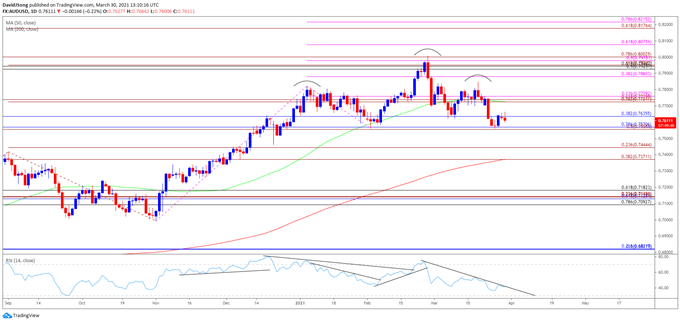Australian Dollar Talking Points
AUD/USD struggles to retain the rebound from the monthly low (0.7563) as the US 10-Year Treasury yield climbs to a fresh yearly high (1.77%), and the failure to defend the February low (0.7564) casts a bearish outlook for the exchange rate as a head-and-shoulders formation takes shape.
AUD/USD Technical Outlook Mired by Head-and-Shoulders Formation
AUD/USD appears to be following its New Zealand counterpart as the exchange rate slips to a fresh yearly low (0.7563) in March, and the decline from the February high (0.8007) may turn out to be a change in market behavior rather than a correction in the broader trend as the exchange rate is on the cusp of breaking the neckline of the head-and-shoulders formation.
A measured move of the key reversal pattern brings the 200-Day SMA (0.7373) well within the striking distance as AUD/USD stands at risk of giving back the advance from the December low (0.7338), with the Relative Strength Index (RSI) highlighting a similar dynamic as it continues to track the downward trend from earlier this year.
In turn, AUD/USD may continue depreciate ahead of the next Reserve Bank of Australia (RBA) interest rate decision on April 6 as the central bank relies on its emergency tools to achieve its policy targets, and it seems as though Governor Philip Lowe and Co. will continue to utilize the quantitative easing (QE) program in 2021 as “a further $100 billion will be purchased following the completion of the initial program.”
It remains to be seen if the RBA will adjust the forward guidance over the coming months as the central bank pledges to “not increase the cash rate until actual inflation is sustainably within the 2 to 3 per cent target range,” but the head-and-shoulders formation in AUD/USD has spurred another shift in retail sentiment as traders flip net-long the pair for the second time in March.
The IG Client Sentiment report shows 54.55% of traders are currently net-long AUD/USD, with the ratio of traders long to short standing at 1.20 to 1.
The number of traders net-long is 1.27% higher than yesterday and 7.36% higher from last week, while the number of traders net-short is 0.18% higher than yesterday and 11.55% higher from last week. The rise in net-long interest has spurred a flip in retail sentiment as 49.88% of traders were net-long AUD/USD on March 17, while the increase in net-short position comes as the exchange rate struggles to retain the rebound from the monthly low (0.7563).
With that said, the decline from the February high (0.8007) may turn out to be a change in market behavior rather than a correction in the broader trend amid the flip in retail sentiment, and the failure to defend the February low (0.7564) casts a bearish outlook for the exchange rate as a head-and-shoulders formation takes shape.


Recommended by David Song
Learn More About the IG Client Sentiment Report
AUD/USD Rate Daily Chart
Source: Trading View
- Keep in mind, the AUD/USD correction from the September high (0.7414) proved to be an exhaustion in the bullish trend rather than a change in behavior as the exchange rate traded to fresh yearly highs throughout December.
- At the same time, developments in the Relative Strength Index (RSI)showed the bullish momentum gathering pace as the indicator pushed into overbought territory for the first time since September, with the break above 70 accompanied by a further appreciation in AUD/USD like the behavior seen in the first half of 2020.
- However, a textbook RSI sell signal emerged following the failed attempt to test the March 2018 high (0.7916), with AUD/USD trading to fresh 2021 lows in February as it failed to preserve the January range.
- Nevertheless, the pullback from the January high (0.7820) turned out to be a short lived, with AUD/USD trading to fresh yearly highs to negate the scope for a double-top formation.
- As a result, the decline from the February high (0.8007) may also be another exhaustion in the broader trend, but failure to defend the February low (0.7564) casts a bearish outlook for AUD/USD as a head-and-shoulders formation takes shape, with the RSI highlighting a similar dynamic as it tracks the downward trend from earlier this month.
- Need a break/close below the neckline around 0.7560 (50% expansion) to 0.7570 (78.6% retracement) to bring the downside targets on the radar, with the first area of interest coming in around 0.7440 (23.6% expansion) followed by the 0.7370 (38.2% expansion) area, which lines up with the 200-Day SMA (0.7373).
- A measured move of the head-and-shoulders formation brings the 0.7180 (61.8% retracement) area within the scope of the key reversal, with the next region of interest coming in around 0.7130 (61.8% retracement) to 0.7140 (23.6% expansion).


Recommended by David Song
Traits of Successful Traders
— Written by David Song, Currency Strategist
Follow me on Twitter at @DavidJSong



Be the first to comment